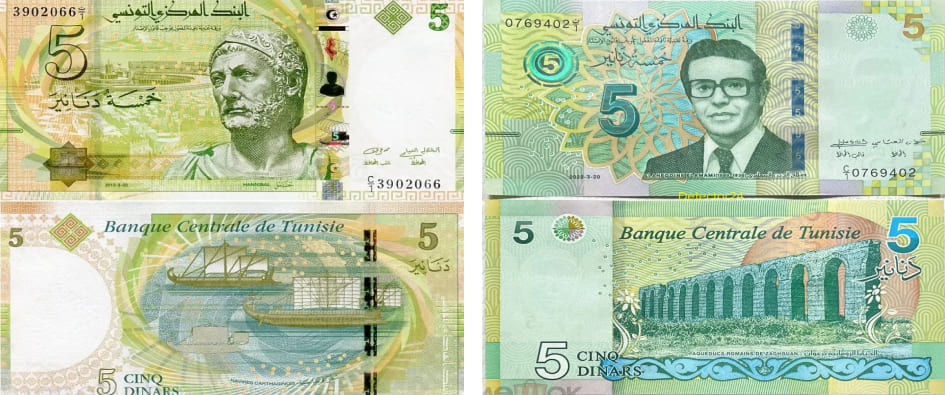


On April 28, 2022 the Central Bank of Tunisia put into circulation two new Tunisian banknotes, so don’t get confused if you see some other people instead of familiar Hannibal and Ibn Rachik on fifty dinar and five dinar notes. The new banknotes will circulate along with other notes which are already in circulation, they are absolutely legal means of payment.
Read the article to find out what they look like.

On an old five dinar banknote you could see a portrait of Hannibal, an outstanding commander from the legendary Carthage who is widely regarded as one of the greatest military tacticians and generals of antiquity.
A new banknote depicts a talented agricultural engineer Slaheddine El Amami who made a significant contribution to solving the problem of arid and semi-arid zones, he was one of the creators of the water supply system in Tunisia and the head of the regional innovative Project on Improving Irrigation and Drainage Techniques, implemented in cooperation with UNESCO and the Food and Agriculture Organization of the United Nations. The results of the research conducted as a part of this project are still considered to be the world standard in the field of salt water use in irrigation. Slaheddine El Amami was born in Sfax in 1936, died in 1986.
The dimensions of the note which has been issued in 2022 are 143 x 73 mm, the color scheme is green.


In the right and left borders on the front of the note there is a raised bar for the benefit of the visually impaired.
There was a portrait of Ibn Rachik on an old fifty dinar note. He was a famous medieval Arab poet who was born in Algeria, but got an education in Kairouan, that’s why he is also called Ibn Rachik Al Kairouani. On duty at the sultan’s court, the poet wrote panegyrics for the ruler, but he did not limit himself to them. His poems ridiculed the stupidity of officials and court squabbles, and because of that Ibn Rachik eventually had to flee to Egypt where he lived until his death.
On a new fifty dinar note you can see a portrait of Hedi Nouira, one of the Founding Fathers of the Republic of Tunisia, who went from exile and prisons to the top of political power. Hedi Nouira founded the Central Bank of Tunisia and in 1958 became its first manager. Since 1970, during the presidency of Habib Bourguiba, he had been serving as the Prime Minister of Tunisia for ten years, and these years in the history of the country are associated with the economic growth and major reforms. Hedi Nouira was born in 1911, died in 1993.
The dimensions of the note which has been issued in 2022 are 158 x 79 mm, the color scheme is brown.


In the right and left borders on the front of the note there is a raised bar for the benefit of the visually impaired.
Stylized forms of the Arab-Islamic style and various drawings used in the design perfectly complement each other. Both new banknotes, of five and fifty dinars, look beautiful and solid.
The domestic currency in Tunisia is dinars, foreign currency is not accepted in shops, though sometimes you can pay cash US dollars or euros at markets. Travellers can change money at many places, for example, in the state bank, establishments with the sign Bureau De Exchanges, post offices Bureau De Poste or right in hotels.
Every day, the Central Bank of Tunisia publishes the exchange rate, and in every part of the country it’s almost the same, corresponding to the official one. The difference is insignificant even if you’re going to deal with quite large amounts.